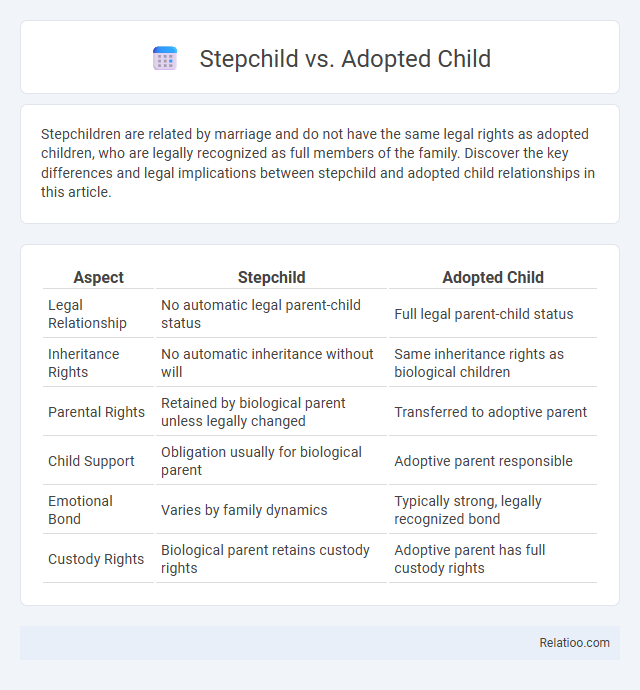Stepchildren are related by marriage and do not have the same legal rights as adopted children, who are legally recognized as full members of the family. Discover the key differences and legal implications between stepchild and adopted child relationships in this article.
Table of Comparison
| Aspect | Stepchild | Adopted Child |
|---|---|---|
| Legal Relationship | No automatic legal parent-child status | Full legal parent-child status |
| Inheritance Rights | No automatic inheritance without will | Same inheritance rights as biological children |
| Parental Rights | Retained by biological parent unless legally changed | Transferred to adoptive parent |
| Child Support | Obligation usually for biological parent | Adoptive parent responsible |
| Emotional Bond | Varies by family dynamics | Typically strong, legally recognized bond |
| Custody Rights | Biological parent retains custody rights | Adoptive parent has full custody rights |
Defining Stepchild and Adopted Child
A stepchild is the biological or adopted child of one's spouse from a previous relationship, without a legal adoption by you. An adopted child is legally recognized as your child through formal adoption proceedings, granting equal rights and responsibilities. Understanding these distinctions clarifies your parental role and legal obligations in blended families.
Key Legal Differences
Stepchildren do not have automatic legal rights to inheritance or custody unless formal adoption processes are completed, whereas adopted children receive the same legal status as biological children, including inheritance and custody rights. Stepchildren require a legal adoption to establish parental rights, whereas adoption severs previous parental rights of biological parents and legally transfers them to the adoptive parents. Custodial and financial responsibilities are legally binding for adoptive parents, while stepparents have no such obligations without formal adoption.
Parental Rights and Responsibilities
Stepchild, adopted child, and biological child each have distinct implications for parental rights and responsibilities, with biological and adopted children generally granting full legal rights and obligations to the parent. Adoption legally establishes parental rights and responsibilities equal to biological parenthood, whereas stepparents typically hold no automatic legal rights without formal adoption or court orders. You must pursue legal adoption or guardianship to secure parental rights over a stepchild, ensuring your responsibilities and decision-making authority are recognized.
Emotional Dynamics in Each Relationship
Stepchild relationships often involve complex emotional dynamics as boundaries are redefined and loyalty conflicts may arise, requiring patience and open communication. Adopted child bonds typically develop through intentional commitment, fostering deep trust and secure attachment that affirm your role as a parent. Blended family dynamics between stepchildren and adopted children can challenge emotional integration but also offer opportunities for building resilience and unconditional love.
Inheritance and Financial Considerations
Inheritance laws vary significantly for stepchildren, adopted children, and biological children, affecting your estate planning. Adopted children are legally recognized as your own, granting them equal inheritance rights, while stepchildren typically do not inherit unless explicitly included in a will or trust. Financial considerations include planning for tax benefits and ensuring proper documentation to secure your stepchild's inheritance rights, which differ from those automatically available to adopted children.
Social Acceptance and Stigma
Adopted children often experience higher social acceptance due to legal recognition and cultural familiarity, while stepchildren may face ambiguity in family roles leading to varied social stigma. Your relationships with stepchildren can be challenged by societal perceptions that question their belonging or legitimacy in the family structure. Understanding these dynamics helps foster inclusive environments that minimize stigma and promote acceptance for all family types.
Blended Family Challenges
Blended families face unique challenges when addressing the legal and emotional distinctions between stepchildren and adopted children, often impacting custody, inheritance, and parental rights. Stepchildren may lack automatic legal rights, requiring formal adoption processes for equal status, which can complicate family dynamics. Establishing clear communication and legal clarity is essential to navigate responsibilities and foster unity within blended family structures.
Role of Biological Parents
The role of biological parents varies significantly between stepchildren, adopted children, and biological children. Biological parents retain legal and emotional responsibilities for a stepchild only if they still hold custody or visitation rights, whereas in adoption, parental rights are fully transferred to the adoptive parents, severing the biological parents' legal ties. Understanding these distinctions helps you navigate parental roles and responsibilities within blended and adoptive families effectively.
Identity and Belonging
Stepchildren often face unique challenges in forming their identity and sense of belonging, as they may feel caught between their biological family and their stepparent's family. Adopted children experience legal and emotional recognition that can strengthen their sense of belonging and solidify their place within the adoptive family. Your support in fostering open communication and acceptance helps bridge gaps of identity and belonging for both stepchildren and adopted children.
Support and Resources for Families
Support and resources for families with stepchildren, adopted children, or biological children vary widely, addressing unique legal, emotional, and financial needs. You can access specialized counseling, legal aid, and community groups designed to guide parenting challenges and inheritance rights specific to each child's status. Family support programs often provide tailored education and assistance to help navigate these relationships effectively.

Infographic: Stepchild vs Adopted Child
 relatioo.com
relatioo.com